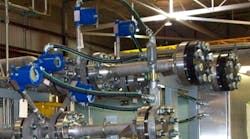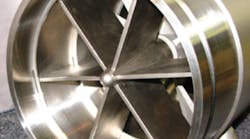Even though turbine flowmeters are losing ground to new-technology flowmeters in some market segments, they still remain a viable choice for steady, medium- to high-speed flows. While the first turbine meter was invented in 1790, these meters were not widely used in industrial markets until after World War II. Since that time, turbine meters have become solidly entrenched in the water, gas, oil, and industrial liquid flow measurement markets.
One main difference between turbine and positive-displacement flowmeters is that turbine meters compute flow based on a velocity measurement, while positive-displacement meters actually capture the flow and measure it volumetrically. Turbine meters excel at measuring clean, steady, medium- to high-speed flow of low-viscosity fluids. Positive-displacement meters, by contrast, excel at measuring low-speed flows and high-viscosity fluids. While there are some applications in which they compete, turbine and positive-displacement flowmeters are more complementary than competing.
There are several reasons why turbine meters will continue to maintain their wide usage for gas flow applications. One is that turbine meters have a significant cost advantage over ultrasonic meters, especially in the larger pipe sizes. Their price may also compare favorably to DP flowmeters, especially in cases where one turbine meter can replace several DP meters. Users who are already familiar with turbine technology and don’t want to spend the extra money required to invest in a new technology are likely to stay with turbine meters.
Secondly, turbine meter suppliers are making technology improvements to make turbine meters more reliable. Many of these improvements involve making the moving parts more reliable. By making the ball bearings out of more durable material, such as ceramic, turbine suppliers have been able to add significantly to the life of the bearings. This is important, since some customers select new-technology meters over turbine meters because turbine meters have moving parts.

